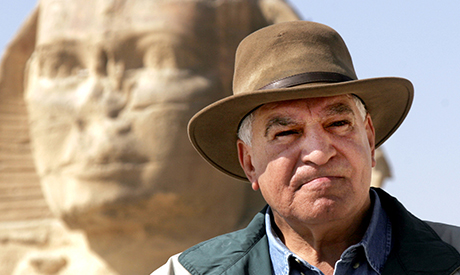Tutankhamun’s tomb may house lost grave of Nefertiti
The Egyptian queen was known as the "Lady of the Two Lands"

Almost a century after Howard Carter swept away three millennia of dust and rubble to open the tomb of King Tutankhamun, you might think it would have yielded up all its mysteries.
You would be very wrong, according to a new theory advanced by a leading expert on ancient Egypt.
Nicholas Reeves, an English archaeologist at the University of Arizona, claims to have found a bricked-up and hitherto unnoticed portal leading out of Tutankhamun’s burial chamber.
Behind it, he suggests, is the holy grail of Egyptology: the lost grave of Nefertiti, the powerful and notoriously beautiful “Lady of the Two Lands” who may have been the boy-king’s mother and ruled alongside him.
Poring over high-resolution digital scans of the walls of Tutankhamun’s grave complex in the Valley of the Kings, Dr Reeves spotted what he believes to be the “ghosts” of two doorways that had been blocked up by the tomb builders.
One of these is thought to lead into a cramped store room. If Dr Reeves’s hunch about the other portal is right, however, he has hit upon one of the most remarkable archaeological discoveries in decades.
Set on the north side of Tutankhamun’s tomb, the room contains nothing less than “the undisturbed burial of the tomb’s original owner — Nefertiti”, Dr Reeves argues in a monograph.
“The implications are extraordinary,” he wrote. “If digital appearance translates into physical reality, it seems we are now faced not merely with the prospect of a new, Tutankhamun-era store room to the west; to the north appears to be signalled a continuation of tomb KV62, and within these uncharted depths an earlier royal interment — that of Nefertiti herself, celebrated consort, co-regent, and eventual successor of pharaoh Akhenaten.”
Experts have long been puzzled by the modest size of Tutankhamun’s burial chamber, which has about the same dimensions as an antechamber. Dr Reeves said that the discovery of a hidden door suggested that the pharaoh’s room was merely an afterthought, the outer section of a “corridor-style tomb-within-a-tomb”.
The opening seems to have been plastered over and decorated with religious scenes at an earlier date than the other three walls of the tomb as a “blind” to confer ritual protection on the secret chamber behind it, he wrote. “Only one female royal of the late 18th Dynasty is known to have received such honours, and that is Nefertiti.”
Dr Reeves also thinks that Nefertiti may lie behind Neferneferuaten and Smenkhkare, shadowy women whose names appear on some of Tutankhamun’s lavish grave goods.
In fact, as much as 80 per cent of the artefacts that dazzled the world when they were first uncovered in 1922 — even the famous solid-gold death mask and canopic jars containing embalmed organs — were recycled from earlier burials, Dr Reeves wrote.
Burdened with more honorifics than a North Korean dictator, including “Lady of All Women” and “Mistress of Upper and Lower Egypt”, Nefertiti was the chief consort of the pharaoh Akhenaten, who ushered in a golden age late in the 14th century BC.
The whereabouts of her grave are a stubborn enigma. Some scholars think she was buried in Amarna, the capital city founded by her husband, while others argue over the identification of two mummies found 250 miles upriver in the Valley of the Kings. Joyce Tyldesley, senior lecturer in Egyptology at the University of Manchester, said that Dr Reeves’s hypothesis was worthy of serious consideration.
“It would not be surprising if the tomb had been intended to have additional rooms, although how far the builders got with these rooms it is difficult to say on current evidence,” she said.
“I would be very surprised if this tomb was built to house the original, or first, burial of Nefertiti, as it seems to me that it is highly likely that she died during her husband’s reign and so would have been buried at Amarna, the city purpose-built by Akhenaten in Middle Egypt.
“Whether or not her body was subsequently transported to Thebes by Tutankhamun, who may have been her son, is difficult to say. There is good evidence that he did move some of the Amarna royal bodies. But I would have expected her to be buried somewhere in the Western Valley, rather than in the centre of the Valley of the Kings.”
Chase the lady
Finely sculpted limestone busts of Queen Nefertiti have made her perhaps the most famous ancient Egyptian woman, but her resting place is mired in controversy.
Many academics believe she was buried at Amarna, on the east bank of the Nile, where the best-known sculpture was unearthed. Crafted in 1345BC, it is now displayed at the Neues Museum in Berlin.
In 1898 two female mummies were found in the tomb of Amenhotep II. The elder was briefly thought to be Nefertiti, but DNA tests later showed it to be Tiye, Akhenaten’s mother. The identity of the other remains a mystery. In 2003, Joann Fletcher, of the University of York, suggested that it might be Nefertiti, but her theory has been hotly disputed.
http://www.thetimes.co.uk/tto/science/a ... .ece#tab-4

